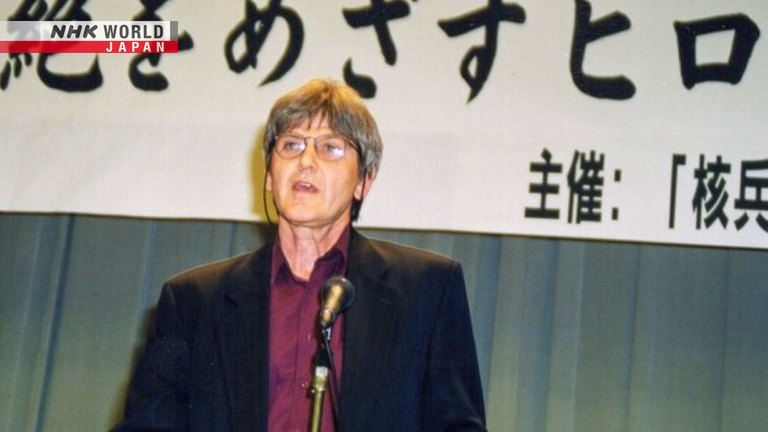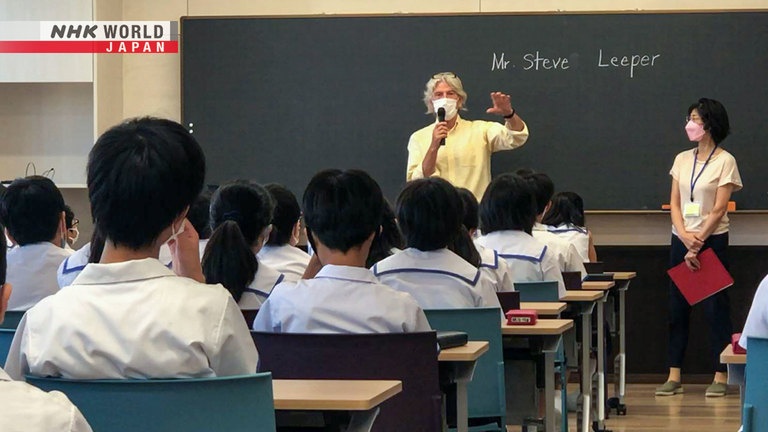What Is Peace?: Steve Leeper / Peace Activist
We focus on Steve Leeper, the first American who had served as chairman of the Hiroshima Peace Culture Foundation and has long been calling out how nuclear weapons have had disastrous consequences.



Transcript
Direct Talk
There is no end in sight
for the Russian invasion of Ukraine.
The specter of a nuclear war once again
looms over the world.
American peace activist Steve Leeper
calls loudly for the realization
of a nuclear-free world.
Leeper was the first non-Japanese
to serve as chairman of the
Hiroshima Peace Culture Foundation,
which operates the
Hiroshima Peace Memorial Museum,
and he is calling on the world
to abolish nuclear weapons.
If we want to live in a peaceful world,
we have to get rid of nuclear weapons,
because that is the obstacle to cooperation.
What is peace?
Discover how one American
learned about peace,
firsthand, from the people of Hiroshima.
What Is Peace?
This is Hiroshima's Peace Memorial Park.
On August 6, 1945,
this area was Hiroshima's commercial heart.
Seven crowded neighborhoods of narrow streets
lined with shops, temples and homes.
These neighborhoods vanished
at 8:15 a.m.
when an atomic bomb exploded
600m over the Shima hospital.
140,000 people were dead
by the end of that year.
40 percent of Hiroshima's population.
But the tragedy of a nuclear weapon
doesn't end with the initial mass slaughter.
Months, years,
and even decades later,
thousands of survivors
found themselves struggling with
and dying from the aftereffects of radiation.
2008
Leeper first visited Hiroshima in 1984.
Until then
becoming a peace activist
was the furthest thing from his mind.
So I went to Hiroshima
to see some friends there,
and while I was there,
the YMCA asked me to speak English,
I mean, to teach English.
I was just trying to teach English
and I got involved in editing.
You know for native check for translations.
If you are doing translation,
you are doing translation
about the atomic bombing,
about peace,
about politics.
So we became involved in translating material
regarding peace and
nuclear weapons and all of that.
Also, Mayors for Peace just started right.
Hiroshima and Nagasaki were
just starting Mayors for Peace.
1985 was the first general conference.
And so we translated for
that general conference.
And so gradually,
just gradually, I came to understand
that nuclear weapons are actually the key,
the key problem that we have to solve.
India-Pakistan Nuclear Tests
May 1998
Then, in 1998
a world-threatening incident occurred.
India conducted
three underground nuclear tests.
If Japan had nuclear weapons,
it would not have experienced
what it did in Nagasaki and Hiroshima.
Leeper visited India
to campaign against nuclear weapons
and to explain their true nature to people.
These were his first steps
as a peace activist.
Tadatoshi Akiba, the mayor at the time,
thought highly of Leeper's
character and abilities.
Tadatoshi Akiba
Hiroshima Mayor (1999-2011)
And then in 2007,
Mayor Akiba said,
"How about coming and being the chairman
of the Peace Culture Foundation?"
And I thought that was a joke at first,
cause you know it's impossible
for me to manage
a big Japanese organization.
I can't do it.
But he said, "No, you don't have to
worry about managing it.
All I want you to do
is concentrate on getting more people,
money and energy for Mayors for Peace."
The Hiroshima Peace Memorial Ceremony
6th Aug, 2007
In 2007, Leeper took up the position.
This year, an American Steven Leeper
assumed the post of the
chairman of board directors
of Hiroshima Peace Culture Foundation.
He is the first non-Japanese
to lead the foundation...
Because "cities suffer most from war,"
Mayors for Peace,
with 1,698 city members around the world,
is actively campaigning to eliminate
all nuclear weapons by 2020.
Steve Leeper translated
Mayor Akiba's peace declaration.
And also, one more thing.
Before I even joined,
Mayor Akiba had organized
101 A-bomb exhibitions in the United States.
That was the big project.
From fall of 2007 until fall of 2008,
that was what I was doing,
and I spent six months of that time
in the United States
going with survivors.
We went to 53 cities.
We must have given 150 presentations to
various places all around the United States.
And I discovered
that most Americans really do not
understand the problem of nuclear weapons.
They don't know how big
and bad these weapons are.
I do believe that we changed a lot of minds,
or we opened up a lot of minds,
to the possibility that, or to the, the idea
that we should get rid of nuclear weapons.
Apart from Mayor Akiba,
two other people had a major
influence on Leeper's life.
The first was his father, Dean,
who moved his family to Japan for
his missionary work when Leeper was a baby.
However...
He went to Hokkaido,
coming back from Hokkaido to Honshu.
He was in the Toya Maru jiken
and this was a shipwreck,
so he died.
Just before I was seven.
The Toya Maru for Aomori departed Hakodate
with 1,127 passengers in 50-meter winds.
The ship suffered major damage minutes later,
resulting in Japan's greatest maritime disaster.
Many, many people in Japan told us
that he had been sort of a hero in the boat.
He was helping people
put their life jacket on.
He gave his life jacket to somebody
and he was trying to calm people.
He did not just think of himself.
So we have always been very proud of that.
I'd like to tell you a bit about my big news
of the trip down to Indonesia.
The invitation suddenly came from
headquarters in Geneva,
the World's Student Christian Federation.
This is 1951,
and he was very
worried about the Korean War.
And he went to Indonesia and to other places
to take part in peace conferences
to try to prevent the Korean War.
After I heard that tape,
I really felt I was doomed
to become a peace activist.
I had no choice about this.
That is, my DNA is Peace activity.
Leeper was also impacted by Ichiro Moritaki,
an atomic bomb survivor
and a world advocate for the peace movement.
Ichiro Moritaki (1901-1994)
Peace activist
If there were a nuclear war today,
we would no longer
be able to live on this planet.
Ichiro Moritaki.
I consider him a great hero.
He really taught me the importance
of the nuclear weapons situation
and the necessity of cooperation
and of not having wars, right?
"We have to give up war,"
he was saying,
and he said so very powerfully.
A teacher in Hiroshima in 1945,
Moritaki was exposed to the atomic bomb,
four kilometers from the epicenter.
The city, where he was born and raised,
vanished in an instant.
He was thinking very deeply
about this new weapon
that crushed his city in 10 seconds.
One bomb
crushes a whole city in 10 seconds,
and he is thinking about
the meaning of this new weapon.
And, he came up with
two very important insights.
One of those is that
human beings can no longer
resolve our conflicts
through contests of destructive power,
which is war.
We can't have a war with nuclear weapons.
That would be the end of us.
The other insight that he had is
that we live in a civilization of power,
structured by power. So,
he is saying we have to graduate from
this pursuit of power civilization
to a civilization of love.
So the civilization of love means
that you are trying to make everybody
healthy and happy, right?
You know, we care about everybody,
or human beings have no future.
Actually, It's not the weapons,
it's the mindset behind the weapons.
It's the attitude of animosity,
hatred,
competition,
cutthroat, violent competition.
That's what nuclear weapons mean.
All of that takes cooperation,
and we can't do that
if we are threatening to kill each other.
After years of calling for
the abolition of nuclear weapons,
Leeper holds grave fears
for the Russo-Ukraine conflict,
the end of which seems out of reach.
I'm afraid that they are, really
both sides cannot give up.
I'm afraid of that.
And I am even very worried that
this could become a nuclear war.
Neither side will back down.
And if they don't back down,
where did they go?
They could go to nuclear weapons,
it seems to me,
so we need,
that's why right now
it's so important to build
public awareness
and raise consciousness
so that the public says no,
we will not,
we refuse to get into this fight.
These days, Leeper shares his time
between Japan and the U.S.
He now dedicates himself to educating
the younger generations about peace.
He has a ready response when he's asked
"What is peace?"
Ah, my favorite way is
peace is social health.
Peace is social health,
and what I mean by that is
that if you look at your body,
your body is made of about 30 trillion cells.
All of those cells have to be
receiving enough food,
enough oxygen,
clean water, right?
They have to be in a good environment.
If all of my cells are doing
what they are supposed to be doing,
then I am healthy.
But if I have some kind of damage,
you know, somebody cuts me with a knife
or shoots me with a gun,
or I get sick,
then part of my body
is not working properly anymore.
Right now that is happening to Ukraine.
So the world is clearly not healthy, right?
We are not in a healthy situation,
so we need to have working toward
making everybody healthy and happy.
That is the job for us now.
What does Steve Leeper strive for?
What I have written here
is "universal health and well-being."
This is what I think
we all need to be working on.
We need to make everyone
in the world healthy and happy,
including animals, plants,
water, air,
earth, soil, everything.
We need a healthy planet.
Universal health and well-being.